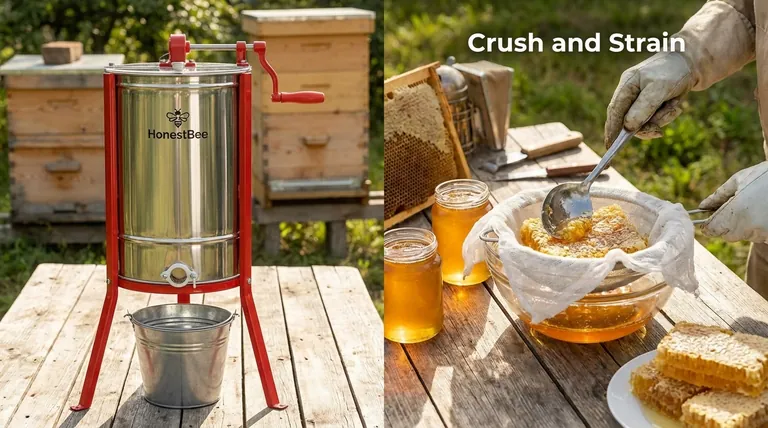Yes, you can absolutely extract honey without a mechanical extractor. For small-scale beekeepers or those using hives without standard frames, non-extractor methods are not only possible but common. The two primary techniques are the "Crush and Strain" method, which separates honey from the comb, and preparing "Cut Comb," where the honey is consumed directly within its wax.
The central decision is not about getting honey, but about the fate of the honeycomb. Non-extractor methods are simple and low-cost but destroy the comb, whereas an extractor preserves it, saving your bees significant energy and boosting future honey production.

Two Methods for Manual Honey Extraction
If you don't have an extractor, your choice of method depends on how you intend to consume the honey and the type of foundation in your frames.
The Crush and Strain Method
This is the most common alternative to mechanical extraction. The process involves cutting the honeycomb out of the frame, crushing it to break open the wax cells, and then pouring the mixture through a sieve or cheesecloth to separate the liquid honey from the wax debris.
This method is straightforward and effective for any type of comb you are willing to sacrifice. It's a fun and easy way to harvest honey, especially from natural combs.
The Cut Comb Method
This isn't an "extraction" method in the traditional sense, but rather a way of preparing honey to be eaten as a complete product—wax and all. You simply use a knife to cut out clean sections of capped honeycomb from the frame.
This approach is best suited for frames that have no foundation or use a special, extra-thin wax foundation. The wax from standard plastic or thick wax foundation is not pleasant to eat, making it unsuitable for cut comb.
Understanding the Trade-offs: Why Extractors Exist
While manual methods work perfectly well, understanding why extractors are the standard for most beekeepers helps clarify the core trade-off you are making.
The Cost of Destroying Comb
The biggest downside of the crush and strain method is implied in its name: you must crush the comb. Bees expend an immense amount of energy and consume significant nectar resources to produce and shape every single wax cell.
When the comb is destroyed during harvest, the colony must start from scratch. This rebuilding effort diverts their energy away from foraging and honey production for the next season.
The Benefit of Preserving Comb
A honey extractor uses centrifugal force to sling honey out of the cells while leaving the delicate wax structure completely intact. The beekeeper can then return these empty, undamaged frames (called "drawn comb") to the hive.
The bees can immediately begin refilling these frames with new honey. This provides a massive head start and is the key to maximizing honey yields over time.
Efficiency at Scale
For anyone managing more than a couple of hives, an extractor is a critical tool for efficiency. An electric extractor, in particular, allows a beekeeper to process a large number of frames quickly, which is simply not feasible with manual crushing and straining.
Making the Right Choice for Your Goal
Your harvesting method should be a deliberate choice based on your goals, budget, and the scale of your beekeeping operation.
- If your primary focus is simplicity and low startup cost: The Crush and Strain method is an excellent and perfectly valid way to harvest your honey, especially for a new beekeeper with one or two hives.
- If your primary focus is maximizing honey yield over the long term: Investing in an extractor is crucial because preserving the comb gives your bees a massive advantage for future production.
- If your primary focus is offering a unique, natural product: Preparing Cut Comb is the best approach, presenting honey in its most raw and beautiful state.
Ultimately, choosing the right honey harvesting technique is about aligning your equipment with your personal beekeeping philosophy.
Summary Table:
| Method | Best For | Key Consideration |
|---|---|---|
| Crush & Strain | Small-scale beekeepers; any comb type | Destroys the honeycomb, forcing bees to rebuild |
| Cut Comb | Beekeepers selling a unique product; foundationless/thin wax frames | Honey is eaten wax and all; not suitable for standard foundations |
| Extractor | Beekeepers focused on maximizing long-term yields | Preserves comb, saving bees energy and boosting future production |
Ready to Scale Your Honey Harvesting?
Whether you're a commercial apiary looking to maximize efficiency or a distributor sourcing reliable equipment, the right tools make all the difference. HONESTBEE supplies durable, high-performance beekeeping equipment—including honey extractors designed for heavy use—through our wholesale-focused operations.
Upgrade your operation with equipment built for productivity. Contact our team today to discuss your needs and get a quote.
Visual Guide

Related Products
- 2 Frame Stainless Steel Manual Honey Spinner Extractor for Beekeeping
- 6 Frame Manual Stainless Steel Honey Extractor Beekeeping Equipment
- electric honey extractor honey centrifuge 3 frame honey extractor stainless steel honey frame extractor
- Plastic Hand Crank 2 Frame Honey Extractor Low Price
- HONESTBEE 3-Frame Manual Acrylic Honey Extractor
People Also Ask
- What are some tips for using a honey extractor effectively? Maximize Your Honey Yield and Protect Your Comb
- How do beekeepers harvest honey from the honey super? A Step-by-Step Guide to Efficient Extraction
- Can a manual extractor be upgraded to an electric one? Save Labor & Boost Efficiency
- What are the consequences of leaving honey in an extractor? Protect Your Honey Quality and Equipment
- How does centrifugation work in honey extraction? The Sustainable Method for Modern Beekeepers



















